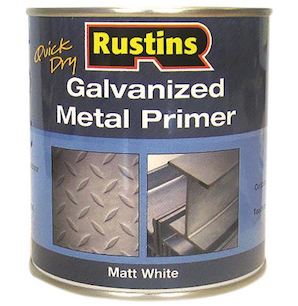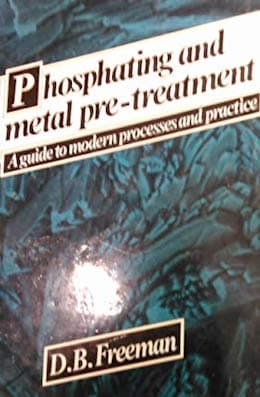
-----
Paint Galvanized Steel Reliably
Q. Painting galvanized metal with cold galvanizing, then finish coat over that to avoid adhesion problem?
I have browsed these forums but have not found discussion of this specific approach.
I have had good luck coating old wrought iron fencing with ZRC cold galvanizing compound brushed on, then finish coating with Acrylic DTM paint from Sherwin Williams.
In this case, I need to put up new railing, made of galvanized pipe and Klee galvanized pipe rail fittings, and paint it. Since the DTM seems to stick fine to ZRC cold galvanizing compound, will the cold galvanizing compound stick to the factory galvanizing on the rail and fittings? If so, the prep would be simple (brush or spray cold galvanizing compound).
The paint adhesion problems seem to be related to factory galvanizing. Would this approach work?
- Chicago, Illinois
May 5, 2021
A. Hi Dan. I seriously doubt that cold galvanizing compounds have some silver bullet approach to adhesion; rather I think they are just primers with a high concentration of zinc compounds in them. Thus I see no particular benefit to applying a cold galvanizing compound under your primer ... but I can't say whether a DTM paint from Sherwin Williams or a different primer made for galvanized and aluminum surfaces is better.
The overall question of adhesion of paint onto galvanized surfaces is rather complicated but is addressed in our FAQ "What is Galvanizing? -- and what if the paint won't stick?"
Luck & Regards,

Ted Mooney, P.E. RET
Striving to live Aloha
finishing.com - Pine Beach, New Jersey
Ted is available for instant help
or longer-term assistance.
span class="replyButton">
Q. I believe that cold galvanizing compounds like ZRC are essentially liquid zinc, not primer. So would cold galvanizing stick to factory galvanizing? I guess that is the question.
Dan Nehm [returning]- Chicago, iL
May 7, 2021
A. Hi again. You may be right, but in that case I don't know what liquid zinc is, and can't say whether it sticks to the various types of factory galvanizing better or not. Sorry.
The SDS is at https://www.zrcworldwide.com/images/pdfs/msds/SDS_GHS_US_ZRC_Liquid_0220.pdf.
Luck & Regards,

Ted Mooney, P.E. RET
Striving to live Aloha
finishing.com - Pine Beach, New Jersey
Ted is available for instant help
or longer-term assistance.
Q. Since nobody seems to know whether cold galvanizing will stick to factory hot galvanizing, I may try another route.
I might try removing the oil, and the passivation layer, which from what I am reading are the two things that cause the paint adhesion problem on new galvanized metal. Then paint with Sherwin Williams Acrylic DTM.
I found a commercial product online that claims to do this: Krud Kutter Metal Clean and Etch. This seems to be a phosphoric acid compound. However this seems to be backordered everywhere.
An alternative found in browsing is to wash with TSP to remove the oil, then with vinegar
⇦in bulk on
eBay
or
Amazon [affil link] . But there seems to be no indication of how reliable this is, whether to dilute the vinegar, or how long to leave it on. I have found vinegar described as a way to remove galvanizing entirely and that is something I do not want to have happen.
Will vinegar substitute for Krud Kutter/phosphoric acid, is dilution required, and how long should it stay on?
- Chicago, Illinois
A. Hi again. This is a public forum not a consulting service so "nobody seems to know" may no longer be true tomorrow, or next week, or next month, depending on who stumbles in & when :-)
I'm confident that Krud Kutter has competitors, but if you use vinegar I'd dilute between 1:1 and 2:1, probably no more. Whatever is going to happen will probably not take longer than a half-minute or minute ... then rinse.
You named 2 causes of poor adhesion but there is a third, perhaps even more important: the fatty acids in alkyd paint react with the zinc to form soaps, causing the paint to slide right off the galvanizing. Acrylic, latex, or other water-based primers are a much better idea than oil-based paints.
Luck & Regards,

Ted Mooney, P.E. RET
Striving to live Aloha
finishing.com - Pine Beach, New Jersey
Ted is available for instant help
or longer-term assistance.
A. So called "cold galvanizing" is zinc rich paint, and not really galvanizing at all. So called "factory galvanizing" is the real thing in that it can only be done in a factory, not a field applied coating, nor practical in an amateur fashion.
The problem with getting adhesion on a galvanized surface is a temporary one, and applies to fresh galvanizing - the problem goes away after perhaps 6 months, depending on the environment that the galv steel is in. During this time the zinc starts to oxidise, and it forms a complex of zinc oxide and zinc carbonates, and this stuff adheres really well to the zinc, and paint adheres really well to that oxidation product. So the lowest cost way (perhaps the laziest way?) to get paint adhesion to galvanizing is to leave 6 months between putting outdoors and painting. That's not always convenient. In factory applied powder coatings for example, that's often done the same or next day to the galvanizing. So something else is required. Sometimes called etching, other times a "conversion coating". Systems vary, butt the simplest of a phosphoric acid mixture with a little copper sulphate (often called "T Wash". The acid etches the surface, the soluphgate turns it black so you know what's treated and what missed. Let that dry and then paint. Various factory systems also exist to get adhesion, most involve an acid etch where tiny microcraters are created in the surface of the shiny zinc metal (the galvanizing). Fresh galvanizing can be like glass, and adhesion to glass isn't great as there's no anchors for the paint - no "key" for it to grip to, just a shiny smooth surface. Sandpaper prior to painting isn't just for smoothing, its to score the surface to get grip, adhesion.
There is a paint system developed in Belgium and sold round Europe developed especially for application to fresh new galvanizing. Various marketing names including "Galvacote", this is a silane paint system.
So using ordinary paint on fresh galv without some pretreatment is a recipe for paint loss. Using "cold galv" won't fix the problem, but might help a little. Best do it right!

Geoff Crowley, galvanizing consultant
Crithwood Ltd.
Bathgate, Scotland, UK

⇩ Related postings, oldest first ⇩
Q. I was wondering if it would be possible to paint some galvanized steel beams and extrusions I have with any kind of paint. And if so, would the paint last, and would it ruin the galvanized finish?
Rick Navarro- Anaheim, California
2002
A. Galvanized material can be easily painted successfully. Surface preparation is the key. You need to ask the paint manufacturer if your paint is suitable for a top coat for galvanized material and what the proper surface preparation should be. The paint will enhance the galvanized coating. It will act as a barrier protection for the galvanized material and subsequently the galvanized material will allow the paint to last longer because there is no underlying corrosion. Painting over galvanizing is often referred to as a "duplex coating." It is routinely done for street lights, DOT applications, and various architectural applications.
Mike Stroia- Canton, Ohio
A. Yes, Rick, it is done routinely, but among other things galvanized finishes that are not going to be painted are chromated, whereas galvanized finishes that are to be painted are not. Painting a chromated galvanized finish is not done as easily -- but any galvanized finish can be painted. The American Galvanizers Association has several free on-line brochures.
Although URLs break or change over time, as of April 2015 the following URL leads to an excellent 12-page booklet called "Duplex Systems"
https://www.galvanizeit.org/education-and-resources/publications/duplex-systems-painting-over-hot-dip-galvanized-steel-2012

Ted Mooney, P.E.
Striving to live Aloha
finishing.com - Pine Beach, New Jersey
Ted is available for instant help
or longer-term assistance.
Q. Hello,
I need to know if by any means can we paint on 11 Gauge Galvanized Steel? If yes, then what is requirement for surface preparation and all other information.
Thanks in advance.
Regards,
PURNENDU
designer - Ajax, Ontario, Canada
2007
A. This is a tough question to answer without full context, Purnendu . . . because an individual consumer may be perfectly satisfied with a do-it-yourself paint job, but might find the same quality on an OEM part to be unsatisfactory.
When a consumer is trying to paint existing galvanized steel it may be hard to get good adhesion, but scrubbing with trisodium phosphate (TSP) ⇦ on eBay or Amazon [affil link] and a tampico brush ⇦ on eBay or Amazon [affil link] , followed by a self-etching primer made for galvanized steel may be good enough.
But when an OEM wants to paint galvanized steel, it starts with specifying the galvanized steel. Ideally it will be galvanneal, as used on auto bodies. If not, at least the final chromate treatment should be omitted. Then a conventional phosphatizing treatment at the factory. ASTM D6386 specifies the "Standard Practice for Preparation of Zinc (Hot-Dip Galvanized) Coated Iron and Steel Product and Hardware Surfaces for Painting".
The American Galvanizing Association calls galvanizing followed by painting a "duplex coating" as Mike has advised, and they have several booklets with full details at www.galvanizeit.org. Good luck!

Ted Mooney, P.E.
Striving to live Aloha
finishing.com - Pine Beach, New Jersey
Ted is available for instant help
or longer-term assistance.
Q. Hello. I am the Materials Manager for a metal stampings organization currently stamping and welding a galvanized steel commercial washing machine console. We are currently sending this part out after stamp and weld to a subcontractor to paint. Throughout the 1.5 years this has been in production we will get random spikes in fallout from our paint supplier in the range of 90-100%. They are blaming the galvanizing and/or "outgassing". The material used is at this spec: "HOT DIPPED GALV G90 CS EXTRA SMOOTH, NON CHEM TREAT COATING PER ASTM A653 ZERO SPANGLE - EXTRA SMOOTH FINISH". The issue is what appears to be dirt / trash in the paint. What are possible causes of this? Is there a very specific pretreatment that should be required to E-coat/paint this type of steel? Thanks!
Eric Baker- Louisville, Kentucky
February 12, 2009
A. Hi Eric. The best pre-treatment is zinc phosphatization. Good luck.
Regards,

Ted Mooney, P.E.
Striving to live Aloha
finishing.com - Pine Beach, New Jersey
Ted is available for instant help
or longer-term assistance.
Painting galvanized mesh wire for a jewelry display
Q. Hi I'm Cynthia,
I'm creating a jewelry display using galvanized wire mesh for an art show. I want the mesh to be a certain color other than the steel look. The more attractive your display the more likely you would sell your items. Therefore what type of paint can I use to paint my wire and not have it peeling or be toxic for my jewelry?
- boston, Massachusetts
April 3, 2015
A. Hi Cynthia. We appended your question to a thread on the subject. I suggest scrubbing with TSP, followed by a "self-etching" latex paint made for galvanized surfaces, followed by your choice of type and color of paint.
Regards,

Ted Mooney, P.E.
Striving to live Aloha
finishing.com - Pine Beach, New Jersey
Ted is available for instant help
or longer-term assistance.
April 30, 2015
Hello,
Great information! I read through all the Q&A and had a few sub-questions. I have camper with a shell that is electrogalvanized. It's about 20 years old and generally in good shape. It has a couple of small rust spots were the galvanized wore off (chips, scratches, etc.) The prior owner painted it a couple times and the paint was coming off in sections, so I took all the paint off with a wire brush head on a angle grinder. Now I'm trying to figure out what to do next and fear making a bad decision that causes poor adhesion.
Q1: I was planning to degrease it, lightly sand it, use vinegar as an acid and then paint with primer. Was going to use 123+ primer, but may use a spray can version if I find one at HomeDepot. Once primed I was going to either roll on a acrylic paint or find a gray spray paint that works with galvanized metal. Hopefully this provides good adhesion and is relatively resistant to scratches and chips from rocks. Does this sound like a good plan or do you recommend something different?
Q2: Given it's a camper shell I can't re-galvanize it per se. Too big. But I see cold galvanized spray cans at the store. Would choosing one of those be a better route vs painting?
Any tips would be greatly appreciated. I put so much work into this that I would hate to make a bad decision now.
Thanks
Brett
- San Jose, California USA
A. Hi Brett. Sorry I wasn't able to respond in timely fashion. I think your plan is/was ideal as long as you are sure that the primer is designed for this. You want a latex (water-base) primer because zinc reacts with alkyd chemicals, and "saponifies" (forms a soap layer) between the metal and the paint. I think the cold galvanizing sprays may be appropriate for patching small rust spots, but I doubt that they are necessary, or even as good, as a proper prime coat and top coat. Good luck.
Regards,

Ted Mooney, P.E. RET
Striving to live Aloha
finishing.com - Pine Beach, New Jersey
Ted is available for instant help
or longer-term assistance.
June 2015
Q, A, or Comment on THIS thread -or- Start a NEW Thread


